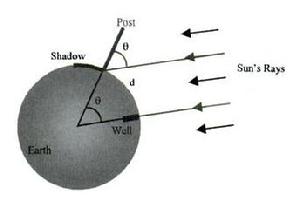|
Vincent Pica
Chief of Staff, First District, Southern Region (D1SR)
United States Coast Guard Auxiliary
|
|
Celestial Navigation 101 – Sailors Always Knew…
|
Going back centuries, journals of seafarers are peppered with language indicating that they knew the Earth was round. “In the offing” meant, and means today, the waters you can see from where you are to the horizon. “Ahoy, captain, vessel off the starboard bow! Hull down, sir.” might yell the Look-Out from the crow’s nest aloft. This meant that all he could see from his vantage point were the sails – the ship’s hull was still below the horizon. So, “round has been around” (pun intended) for thousands of years. Well, how many thousands? About 22 centuries before the epic confrontation between Galileo and the medieval Church, Phoenician sailors circumnavigated Africa, sailing down the east coast and back up the western shores, through the “Pillars of Hercules” at Gibraltar and back to Egypt, to report to the Pharaoh that, indeed, the world must be round. Why? Because, once they crossed southbound what we now know as the equator, the sun had “flipped around” to reside on the opposite side of their sailing vessel on a given sailing tack. At night, the moon would have become “left-handed”, rather than being “right-handed*” as we see it at night. Thus, they knew the world must round, for, if it were flat, such observations couldn’t occur. So, mirabile dictu, as the Romans would come to say, the world was round – but no one knew how big it was. It took a Greek, named Eratosthenes, in 240 BC to figure out how big the Earth was. He noticed that in Aswan, a place then called Syene, around the time of the summer solstice, the sun shined directly to the bottom of a well and nearby posts threw no shadows on the ground. To do that, the sun had to be directly overhead. At the same time, where he lived in Alexandria to the north, a post would throw a shadow on the ground. For both those conditions to be true, the Earth had to be round and the rest, i.e., how big around was it, was simply some algebra and geometry which, as every high school student knows, the Greeks were very good at. So, Q.E.D, this column is about that math and thus starts a series on celestial navigation.
|
 |
| courtesy of John Karl, Celestial Navigation in the GPS Age, Paradise Cay Publications |
|
| Upon One Principle, Celestial Navigation Rests
But what did ol’ Eratosthenes do? Well, the shadow from the post in Alexandria created an angle. Having that in hand, plus the “arc distance” from Aswan(Syene) to Alexandria (d), we have the beginnings of a formula. This angle created by the shadow of the post in Alexandria, called theta to this day and displayed as 0, is exactly the same angle that would be found at the center of the Earth, as if the sunlight that was shining down that well in Aswan(Syene) could reach the center of the Earth and then “bounce” back up and out through Alexandria. In plain speak, the angle from Aswan(Syene) down to the center of the Earth and back out through Alexandria is exactly the same angle as that created by the sun’s shadow thrown from the post in Alexandria. See diagram.
|
Thus, Eratosthenes quickly deduced that the arc distance (d) was proportional to the angle 0. If you halve the angle, you halve the distance. This means that you can create a formula from these facts: d = constant x 0. Ol’ Eratosthenes realized further that “d” would be equal to the circumference of the Earth when the angle, 0, was 360o.
D = (circumference/360o) x 0 had to be the circumference when 0 was 360o!
So, since this was true, all he needed to do was figure out what the constant was, which, knowing the distance from Aswan(Syene) to Alexandria being about 500 miles, he did some algebra and solved for the circumference of the Earth.
Eratosthenes solved the equation above and determined the Earth’s circumference to be 25,500 miles. With our advanced technology, we know the Earth to be 24,874 miles – so pretty darn good for ol’ Eratosthenes with 240 BC technology!
So, upon exactly what principle does celestial navigation rest? Eratosthenes’ formula enables someone to determine how far they are from someplace else. If we take Eratosthenes’ formula one step further, i.e., to solve for the constant that, when multiplied by the observed angle as measured at noon, tells you how far away you are from the “well”, i.e., Greenwich, England, we get this:
- D = (circumference/360o) x
0
- we substitute ‘circumference’ for its equivalent – 2*pi*R (where R is the Radius of the Earth, which we know today to be 3,440 nautical miles)
- D = (2*pi*3440)/ 360o) x
0
- D = 60.04 x
0 or, rounding off,
- D = 60nm.
That is the constant and why 60nm is equal to 1 degree of latitude. This is the kernel upon which celestial navigation rests!
* Being “right-handed” means that the Earth’s shadow moves from the right side of the moon to the left as the moon wanes from a full moon to a new moon, as viewed from the northern hemisphere.
|
BTW, if you are interested in being part of USCG Forces, email me at JoinUSCGAux@aol.com or go direct to the D1SR Human Resources department, who are in charge of new members matters, at DSO-HR and we will help you “get in this thing…”
|
| <-- click there to tweet, post or otherwise distribute to the 'net
Have something to add, ask or pass along? Pls do so below! I promise a response.
|
|